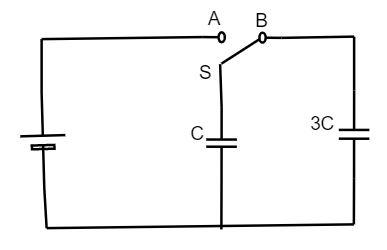
In the figure shown, after the switch $'S'$ is turned from the position $'A'$ to position $'B'$ , the energy dissipated in the circuit in terms of capacitance $'C'$ and total charge $'Q'$ is:
(A) $\dfrac{3}{8}\dfrac{{{Q^2}}}{C}$
(B) $\dfrac{3}{4}\dfrac{{{Q^2}}}{C}$
(C) $\dfrac{1}{8}\dfrac{{{Q^2}}}{C}$
(D) $\dfrac{5}{8}\dfrac{{{Q^2}}}{C}$
Answer
219.9k+ views
Hint: Use the formula of the energy stored in the capacitor and find its answer. Use the formula of the energy liberated and substitute the value of the equivalent capacitance to find its answer. Subtract both the answer to find the value of the energy dissipated to the surrounding.
Formula used:
(1) The formula of the energy stored in the capacitor is given by
$U = \dfrac{1}{2}C{V^2}$
Where $U$ is the energy stored in the capacitor, $C$ is the capacitance and $V$ is the voltage of the capacitor.
(2) The energy dissipated in the circuit is given by
$V = \dfrac{{C{V^2}}}{{2{C_{eq}}}}$
Where $V$ is the energy dissipated to the surrounding and ${C_{eq}}$ is the equivalent capacitance of the circuit.
Complete step by step solution:
From the given circuit diagram, the capacitance of the $C$ and $3C$ are connected parallel to each other. $A$ and $B$ are two switch connections.
Using the formula of the energy stored we get
$U = \dfrac{1}{2}C{V^2}$ ……………………….(1)
Substitute that $C = \dfrac{Q}{V}$ in the above step, we get
$U = \dfrac{{{Q^2}}}{{2C}}$ ……………………..(2)
Using the formula of the energy dissipated to the surrounding, we get
$V = \dfrac{{C{V^2}}}{{2{C_{eq}}}}$ ……………………….(3)
From the circuit, the equivalent capacitance of the circuit is calculated as follows.
$\Rightarrow {C_{eq}} = 1 + 3 = 4$
Substitute this in the equation (2), we get
$\Rightarrow V = \dfrac{{C{V^2}}}{{2 \times 4}} = \dfrac{{C{V^2}}}{8}$ …………….(4)
The change in the energy is obtained by subtracting the (4) and (1),
$\Rightarrow \Delta E = \dfrac{{C{V^2}}}{2} - \dfrac{{C{V^2}}}{8} = \dfrac{{3C{V^2}}}{8}$
Substituting the equation (2) in the above step, we get
$\Rightarrow \Delta E = \dfrac{3}{8}\dfrac{{{Q^2}}}{C}$
Thus the option (A) is correct.
Note: The main work of the capacitance is to collect the energy and to store it. But there will be some loss of the energy and its mainly due to the voltage drop across the capacitor. If the voltage drop is high, then the power dissipation in the capacitor will also be high.
Formula used:
(1) The formula of the energy stored in the capacitor is given by
$U = \dfrac{1}{2}C{V^2}$
Where $U$ is the energy stored in the capacitor, $C$ is the capacitance and $V$ is the voltage of the capacitor.
(2) The energy dissipated in the circuit is given by
$V = \dfrac{{C{V^2}}}{{2{C_{eq}}}}$
Where $V$ is the energy dissipated to the surrounding and ${C_{eq}}$ is the equivalent capacitance of the circuit.
Complete step by step solution:
From the given circuit diagram, the capacitance of the $C$ and $3C$ are connected parallel to each other. $A$ and $B$ are two switch connections.
Using the formula of the energy stored we get
$U = \dfrac{1}{2}C{V^2}$ ……………………….(1)
Substitute that $C = \dfrac{Q}{V}$ in the above step, we get
$U = \dfrac{{{Q^2}}}{{2C}}$ ……………………..(2)
Using the formula of the energy dissipated to the surrounding, we get
$V = \dfrac{{C{V^2}}}{{2{C_{eq}}}}$ ……………………….(3)
From the circuit, the equivalent capacitance of the circuit is calculated as follows.
$\Rightarrow {C_{eq}} = 1 + 3 = 4$
Substitute this in the equation (2), we get
$\Rightarrow V = \dfrac{{C{V^2}}}{{2 \times 4}} = \dfrac{{C{V^2}}}{8}$ …………….(4)
The change in the energy is obtained by subtracting the (4) and (1),
$\Rightarrow \Delta E = \dfrac{{C{V^2}}}{2} - \dfrac{{C{V^2}}}{8} = \dfrac{{3C{V^2}}}{8}$
Substituting the equation (2) in the above step, we get
$\Rightarrow \Delta E = \dfrac{3}{8}\dfrac{{{Q^2}}}{C}$
Thus the option (A) is correct.
Note: The main work of the capacitance is to collect the energy and to store it. But there will be some loss of the energy and its mainly due to the voltage drop across the capacitor. If the voltage drop is high, then the power dissipation in the capacitor will also be high.
Recently Updated Pages
Electricity and Magnetism Explained: Key Concepts & Applications

JEE Energetics Important Concepts and Tips for Exam Preparation

JEE Isolation, Preparation and Properties of Non-metals Important Concepts and Tips for Exam Preparation

JEE Main 2021 July 25 Shift 1 Question Paper with Answer Key

JEE Main 2021 July 22 Shift 2 Question Paper with Answer Key

States of Matter Chapter For JEE Main Chemistry

Trending doubts
JEE Main 2026: Application Form Open, Exam Dates, Syllabus, Eligibility & Question Papers

Understanding Uniform Acceleration in Physics

Derivation of Equation of Trajectory Explained for Students

Hybridisation in Chemistry – Concept, Types & Applications

Understanding the Angle of Deviation in a Prism

Understanding Atomic Structure for Beginners

Other Pages
JEE Advanced Marks vs Ranks 2025: Understanding Category-wise Qualifying Marks and Previous Year Cut-offs

Dual Nature of Radiation and Matter Class 12 Physics Chapter 11 CBSE Notes - 2025-26

How to Convert a Galvanometer into an Ammeter or Voltmeter

Understanding Centrifugal Force in Physics

JEE Main Marking Scheme 2026- Paper-Wise Marks Distribution and Negative Marking Details

Degree of Dissociation: Meaning, Formula, Calculation & Uses




